Connecting state and local government leaders
The state government is urging water conservation. But some cities are issuing citations for not keeping lawns green.
California Gov. Jerry Brown signed legislation this week that would seemingly help out plenty of state homeowners who want to conserve water as the state faces extreme drought conditions. The bill, which received the governor’s signature on Monday, makes it illegal for homeowner associations to fine water-conscious property owners who let their green lawns and landscaping turn brown in the name of conservation.
It fits in with Brown’s ongoing drought message that “Brown is the New Green” in California, where water consumption actually jumped in some parts of the state recently despite ongoing conservation mandates.
Even with the new mandate, which essentially mirrors one of Brown’s earlier executive orders on lawn-watering, some local government officials have been issuing fines and citations to homeowners who are failing to keep their properties green.
It’s happened in the Los Angeles suburb of Glendora, where, according to The Associated Press, a water-saving couple is facing a $500 fine if they don’t get their brown lawn green in 60 days. “Despite the water conservation efforts, we wish to remind you that limited watering is still required to keep landscaping looking healthy and green,” according to the city of Glendora’s letter.
Glendora’s city manager, Chris Jeffries, told Reuters recently that although the city is encouraging water conservation, that isn’t an excuse for residents to simply let their properties whither.
"Conservation does not mean neighborhoods need to deteriorate because property owners want (the) landscape to die or go unmaintained," he said.
Glendora's action provoked a strong response from state environmental officials, who said such moves undermined conservation efforts.
“Throughout the state, Californians are making serious efforts every day to cut their water use during this extreme drought," said Amy Norris, spokeswoman for the California Environmental Protection Agency. "These efforts to conserve should not be undermined by the short-sighted actions of a few local jurisdictions, who chose to ignore the statewide crisis we face."
Agriculture accounts for roughly 80 percent of California’s water use — almond production alone consumes 10 percent of the state’s water — and water districts have cut off or reduced flow to farming. The flow of water for public consumption has also been cut back in some communities. This week, the South San Joaquin Irrigation District announced it will cut drinking water deliveries by 20 percent for August and September to the cities of Tracy, Mateca and Lathrop, which will have to increase groundwater pumping and conserve more, according to The Modesto Bee.
The state has been urging residents to cut back on water use through ongoing education efforts and celebrity public service announcements. Residential use can vary widely by community and income bracket, according to Southern California’s KCET-TV. And within some residential communities, more than 50 percent of their daily water use is for outdoor purposes, like lawns, gardens and swimming pools, according to the state.
There are some success stories. In Santa Cruz, where the local water department has mandated rationing, 94 percent of residents met usage limits in May. Water Director Rosemary Menard told the Santa Cruz Sentinel in late June that it “means that we have gotten the message out to the people doing their part.”
But with the water situation remaining grim, the state is taking more aggressive action.
Last week, California’s State Water Resources Control Board approved an emergency conservation measure that permitted localities to issue fines of up to $500 per day to consumers who waste water in certain excessive ways.
According to the state’s announcement:
Many communities and water suppliers have taken bold steps over the years and in this year to reduce water use; however, many have not and much more can and should be done statewide to extend diminishing water supplies.
With this regulation, all Californians will be expected to stop: washing down driveways and sidewalks; watering of outdoor landscapes that cause excess runoff; using a hose to wash a motor vehicle, unless the hose is fitted with a shut-off nozzle, and using potable water in a fountain or decorative water feature, unless the water is recirculated. The regulation makes an exception for health and safety circumstances.
Larger water suppliers will be required to activate their Water Shortage Contingency Plan to a level where outdoor irrigation restrictions are mandatory. In communities where no water shortage contingency plan exists, the regulation requires that water suppliers either limit outdoor irrigation to twice a week or implement other comparable conservation actions. Finally, large water suppliers must report water use on a monthly basis to track progress.
Some local water districts and governments are starting to crack down on water waste with a few handing out fines.
The board of the Santa Clara Valley Water District, which serves the area in and around San Jose, voted Tuesday to hire 10 temporary “water cops” to step up enforcement, though according to KPIX-TV, they’ll primarily hand out warnings and serve as drought educators.
As The Sacramento Bee points out, last week’s announcement permitting fines and criminal penalties for certain types of water waste extends to public agencies. But there’s a lot of uncertainty about enforcement:
In some cases, that means asking one government agency – the local water district – to intervene with another. Or it may mean one department trying to regulate a sister department. If a citizen reports water waste in a Sacramento city park to the city water department, is there any guarantee the city will police itself? Should the state stand ready to enforce such cases instead?
State government agencies have already met the governor’s call to reduce water use at state properties by 20 percent, according to the Bee.
WATCH: California Gov. Jerry Brown issues a Drought State of Emergency in January 2014




